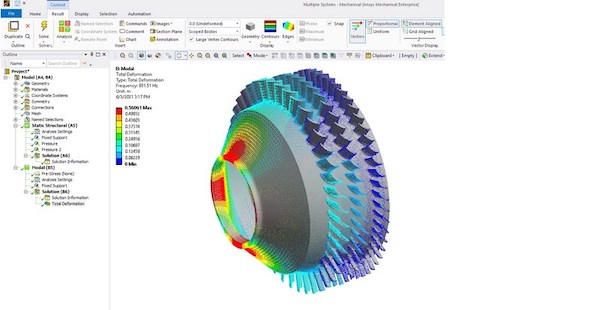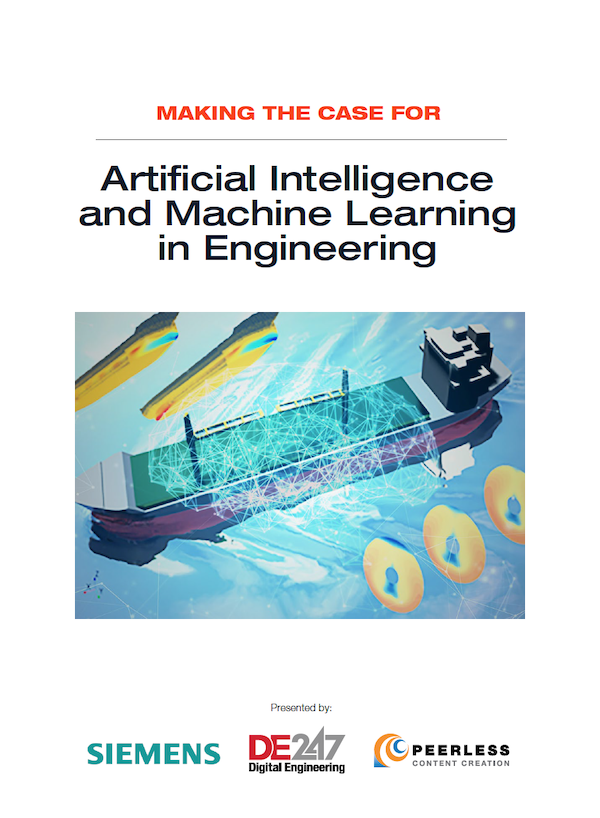Ansys 2021 R2 Accelerates Engineering Exploration, Collaboration and Automation
The latest release increases data visibility and reuse for materials, digital twin components, electronic components and compliance initiatives.

Latest News
July 26, 2021
The newly released Ansys 2021 R2 products improve the user’s ability to explore early stage product design and complex system engineering.
According to the company, with access to nearly limitless computing via Ansys Cloud, engineers who use Ansys 2021 R2 products can increase their speed and flexibility to ask “what-if” during design.
Speed improvements are woven throughout the latest Ansys products. According to the company:
- Productivity enhancements allow engineers to perform optical simulation meshing up to 20X faster and local meshing up to 100X faster.
- Ansys Mechanical 2021 R2 streamlines cyclic modal and structural analyses using a new multistage cyclic symmetry capability that can ultimately decrease run times by up to 50X when compared against a full 360 degree solve.
- In semiconductors, 2021 R2 provides 3nm-ready Advanced Power Analytics (APA) and improves voltage-drop fixing efficiency by 3X, using aggressor identification, what-if analysis and links to engineering change order (ECO) tools.
- Using the cloud for semiconductor simulation delivers at least 4X better cost and core-hour efficiency with Ansys 2021 R2.
- In fluids, Ansys 2021 R2 provides up to a 5X speed increase for high-speed flows to Mach 30 and above, with improved treatment of reaction sources in the density-based solver.
- Simplified, reduced-order workflows throughout Ansys 2021 R2 provide quick answers to product design and development problems, allowing engineers to concentrate computing power on the best design candidates.
- The new Phi Plus mesher meets 3D integrated circuit package challenges by accelerating initial meshing for bondwire package electromagnetics and signal integrity analysis by an average of 6-10x.
“Because of the speed of Ansys HFSS and its ability to solve multiple simulation challenges in different domains, we were able to analyze performance and make design changes more quickly and with better data,” said Doug Stetson, CEO of FreeFall Aerospace. “We were able to build complete models in HFSS which allows us to move directly into the prototyping stage with confidence. Meeting our customer requirements with accuracy and speed is our priority and Ansys HFSS makes that possible.”
In addition to directly speeding up simulation, Ansys 2021 R2 enables engineers to work more efficiently via an open platform that integrates multiple toolsets, according to Ansys. For example, Ansys Mechanical users can embed Python programming language scripts directly into their models to automate the flow using industry standard open-source coding.
Other updates enable teams to efficiently work in an ecosystem that connects early design, simulation, system integration and manufacturing. Many products in the new release incorporate single-click, automated integrations that enable users to leverage additional technology to broaden their scope of simulation. Product and process integration also allows a smooth transfer of data between applications, which increases usability and productivity. For instance, Ansys 2021 R2 delivers new Chip-Package-System (CPS) and printed circuit board (PCB) enhanced workflows with automation for IC-on-Package and Multi-Zone PCBs with rigid flex cables, which are popular in modern electronic devices.
“Ansys is a proven leader in simulating mechanical, electromechanical, thermal and radio frequency transmission to predict undesirable multiphysics interactions – noise, vibration, physical interferences, electromagnetic interferences and material fatigue – all leading causes of product failures,” said Craig Brown, executive consultant at CIMdata. “Ansys provides essential expertise across the scale of tomorrow’s cyber-physical products, understanding silicon engineering workflows as well as system engineering workflows and everything in between to create an innovative and profitable electronics systems product.”
Data visibility and reuse via dashboards and dedicated libraries further increase the efficiency of engineers using Ansys 2021 R2. Libraries for common digital twin components, electronic components and materials enable engineers to quickly access trusted data. For example, materials management updates enable customers using restricted substances to access the latest Supplier Data Sheets (SDSs), ensuring products are compliant with global regulations.
Compliance, certifications and standards are addressed in many updated products. Ansys 2021 R2 is now a one-stop-shop for embedded software certification across all industries, including the highest safety integrity/assurance levels of DO-178C, ISO 26262, IEC 61508, and EN 50128 standards.
“Simulation is not just about solving advanced multiphysics design problems to us,” said Shane Emswiler, senior VP of products. “It includes considering the entire product workflow and function necessary to enable our customers' success. From automotive to industrial to aerospace and advanced electronics, Ansys is the leading provider of mission-critical integrated solutions that help customers build their products and systems for success.”
Sources: Press materials received from the company and additional information gleaned from the company’s website.
More Ansys Coverage
Subscribe to our FREE magazine, FREE email newsletters or both!
Latest News
About the Author
DE’s editors contribute news and new product announcements to Digital Engineering.
Press releases may be sent to them via DE-Editors@digitaleng.news.






